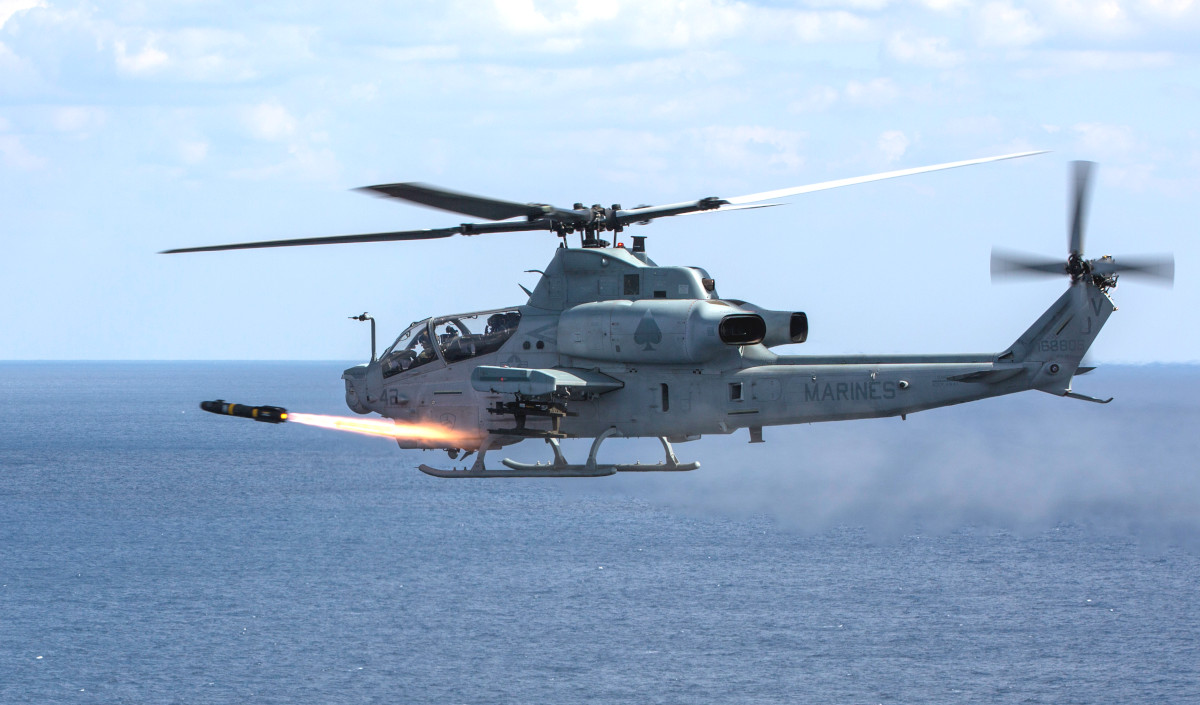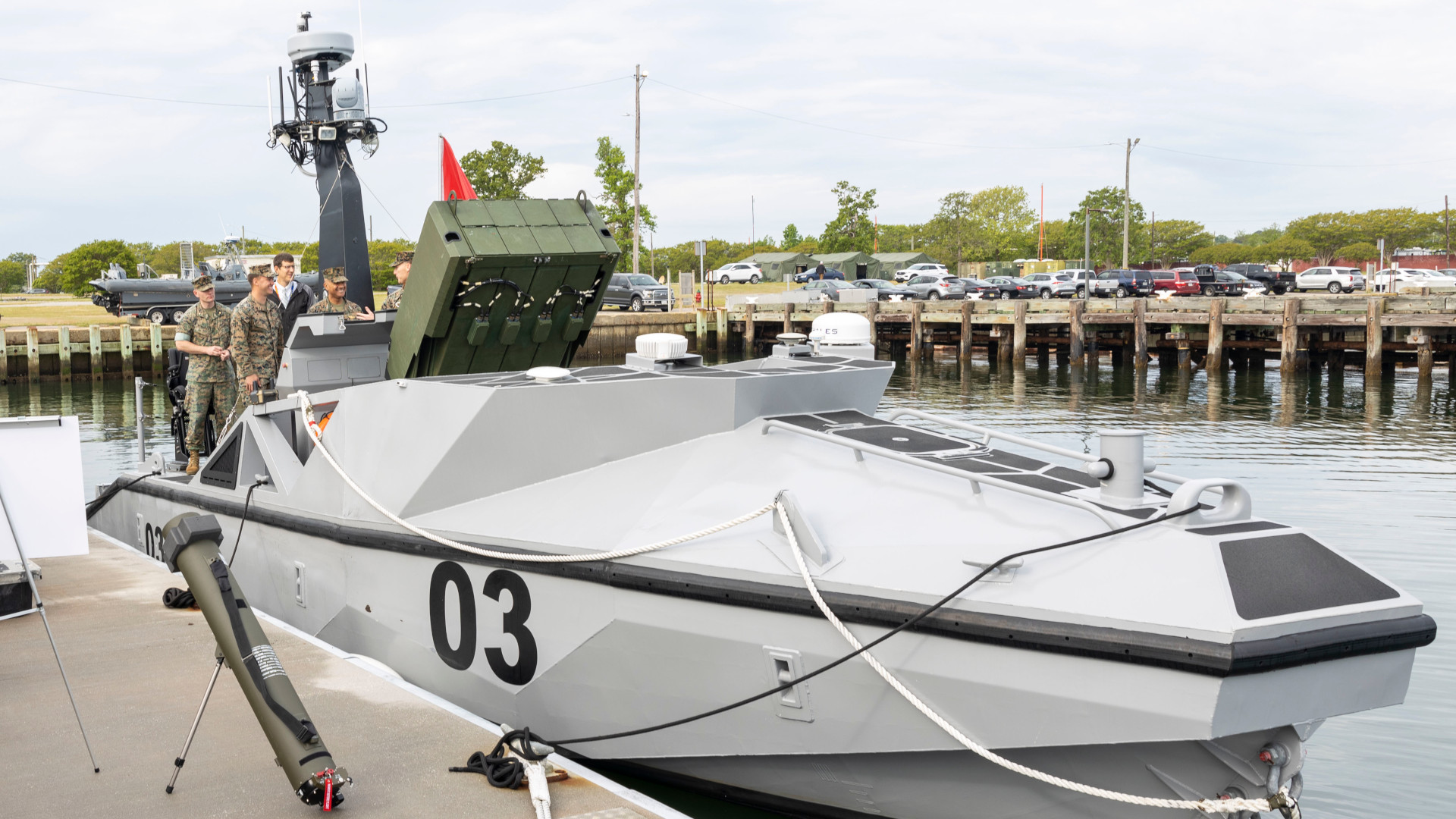The U.S. Marine Corps says the development of a new family of relatively low-cost, long-range air-launched loitering munitions, or kamikaze drones, is “critical” to its new expeditionary and distributed concepts of operations. These future Long-Range Attack Munitions, or LRAMs, would be capable of operating in fully-networks swarms and reaching target areas more than a hundred miles away after launch from Marine Corps F-35B Joint Strike Fighters, MV-22B Osprey tilt-rotors, various types of helicopters, or even KC-130J Hercules tanker/transport planes.
The Marine Corps provided new details about the LRAM effort at a media roundtable last Friday. The kinds of drones would offer Marines a valuable additional means of striking enemy forces and just locating and tracking threats, all at extended ranges. Depending on their exact configuration, they could perform other tasks, including electronic warfare jamming. Being able to operate in a swarm presents its own advantages, including when it comes to overwhelming enemy air defenses.
The press briefing that touched on LRAM came ahead of today’s release of the latest public update on the service’s progress in refining and implementing its new, over-arching force restructuring and modernization plans, known collectively as Force Design 2030. Force Design 2030 is heavily focused on ensuring the Marine Corps has the necessary force structure and assets to succeed in what it calls Expeditionary Advance Base Operations (EABO), as well as in support of other joint service distributed concepts of operations.

EABO is a set of expeditionary and distributed concepts of operation that envisions relatively small groups of Marines being able to readily deploy to forward littoral locations, holding enemy forces in those areas at risk, and then being able to just as quickly redeploy to meet changing operational demands and evade enemy counter-attacks. Though EABO is not region-specific, finding new ways to effectively operate across the broad expanses of the Pacific, including in any potential high-end conflict with China, has been a clear driver behind the overall concept.
“This Long-Range Attack Munition, which we’re experimenting with now, and [that] we would like to bring into the force… within the next few years… is a capability that brings hundreds of kilometers [of range],” Marine Corps Brig. Gen. Stephen Lightfoot, head of the service’s Capabilities Development Directorate, said at the roundtable. “That allows us to be able to use a current platform to be able to do things that we never thought that it would be able to do. And so that Long-Range Attack Munition is absolutely critical.”
A kilometer is roughly sixth tenths of a mile, which means that a loitering munition with a maximum range of “hundreds of kilometers” should be able to reach a target area in excess of at least a hundred miles away.
Otherwise, specific details about what the Marines are looking for in their future arsenal of LRAMs are limited. During the roundtable, Brig. Gen. Lightfoot, whose career has included time as an AH-1 attack helicopter pilot, focused heavily on the added capabilities that new long-range air-launched loitering munitions would give those helicopters over existing weapons like the AGM-114 Hellfire.

“I’m just going to give a quick vignette here. …the AH-1 has been shooting the Hellfire missile for decades now and that missile has the ability to reach out to about eight kilometers [just under five miles], depending on your altitude,” he explained. “That’s great in OIF [Operation Iraqi Freedom], OEF [Operation Enduring Freedom in Afghanistan], and in [other] areas we’ve been fighting for years. But when you move over to the Indo-Pacific, and some of the distances we’re talking about, that eight kilometers doesn’t really do as much as you’d want to have happen.”
Brig. Gen. Lightfoot described LRAM as a “revolutionary capability” compared to Hellfire and one that would help extend the reach of launching aircraft, like the AH-1. This would allow those platforms to stay further away from enemy air defenses, as well, reducing their vulnerability.
At the same time, Hellfire is already slated to be replaced more directly in the Marine Corps, as well as elsewhere across the U.S. military, with the new AGM-179A Joint Air-to-Ground Missile (JAGM), which you can read more about here. The service has also previously made clear that its vision for LRAM is much more expansive than supplanting just one existing weapon on the AH-1.

“With the support of the Office of the Under Secretary of Defense for Research and Engineering’s Joint Capability Technology Demonstration office, we will begin the Long-Range Attack Munition (LRAM) project, to rapidly develop and field a low-cost, air launched, family of loitering and swarming munitions,” Marine Corps Commandant Gen. David Berger wrote in prepared remarks for a hearing before the Senate Appropriations Committee back in March. “The LRAM can be employed by not just H-1s [AH-1Z attack helicopters and UH-1Y armed utility helicopters] and F-35s, but also palletized and employed from MV-22s, CH-53Ks, and C-130s, thereby significantly expanding our magazine depth.”
The basic benefits of enabling various Marine Corps aircraft to launch volleys of long-range strike munitions, potentially against multiple targets from multiple vectors, are obvious. Some of the inherent benefits of a large fully-networked swarm involve being able to overwhelm or otherwise confuse defenders, and getting them to employ likely limited resources in suboptimal ways as a result.
Employing swarms of loitering munitions, which by design occupy a space between more traditional missiles and drones, adds additional capabilities to the mix. Many loitering munition designs have a direct operator-in-the-loop control systems that include sensor feeds that are running right up until the moment of impact. This generally allows for fine course corrections in the terminal phase of flight, which improve accuracy, as well as the ability to wave off a strike should circumstances change, such as the sudden appearance of innocent bystanders.
The video below from Israeli firm UVision highlights the various general capabilities that loitering munitions offer as compared to traditional missiles and drones.

In addition, this means that loitering munitions have secondary intelligence, surveillance, and reconnaissance (ISR) capabilities. As such, a swarm of kamikaze drones can be employed to quickly search for threats across a broad area, provide overwatch or otherwise monitor enemy activities in a particular zone, or just provide general added situational awareness, all before actually striking a target. Some designs can even be recovered and refurbished for reuse after a sortie where they don’t end up carrying out a strike at all.
Loitering munitions can generally be directed to strike static targets based on specific GPS coordinates. Automated target recognition capabilities might also allow for the engagement of very specific types of targets in a specific geographical area without any need for input from a human operator. This could all be especially relevant for employing LRAMs against targets out to their maximum ranges or otherwise in denied areas where it could be difficult, if not impossible for Marine Corps assets to exercise direct control.
Networking together different variants of a single loitering munition design, or multiple types of kamikaze drones, with different capabilities gives the entire swarm more flexibility. Individual drones could carry different kinds of sensors or other payloads, including warheads optimized for different target sets or electronic warfare packages.
Linked together as a single entity where targeting and other data are fused together, the different drones in a single swarm would not all need to be able to perform all functions equally well, either. This, in turn, can help keep the designs simpler and reduce their unit costs.
“And it’s [LRAM] going to help not only in the air… again, as a pilot, I will tell you that aviation platforms as a whole are fantastic when they are airborne. But they’re not always airborne, and they can’t always be airborne,” Brig. Gen. Lightfoot added during the roundtable last week. “So we need to bring that Long-Range Attack Munition also to the ground side, so that it can fire from the ground so it’s ready 24/7 [and] not just simply on an air vehicle.”
This speaks to other potential benefits of long-range loitering munitions, as well as questions about how they might be employed. The Marine Corps has already conducted at least one test involving a UVision Hero-400 loitering munition that saw control of the drone passed from personnel at a ground-based launch site to others flying in a UH-1Y Venom helicopter and then to individuals riding in an unspecified watercraft. You can read more about this event in detail here.

It might be possible to pass off control of an entire swarm in similar ways, or it could be controlled from virtually anywhere via beyond-line-of-sight data links, and this all creates additional layers of flexibility. It could expand the magazine depth of aircraft or ships operating forward that have expended all of the munitions they might have been carrying themselves. Those assets might not be loaded with the most optimal munitions for the target set in question, either. Furthermore, groups of personnel on the ground operation could take over a swarm, or portions thereof, to help scout ahead and/or strike threats.
Later in the roundtable, the Brig. Gen. Lightfoot highlighted that LRAMs are set to be part of a broader future Marine Corps strike ecosystem. This will include multiple tiers of shorter-range, lower-end loitering munitions, such as ones capable of being fired from vehicles and small drone boats, and more traditional ground-launched Naval Strike Missiles and Maritime Strike Tomahawks. The latter two missiles are primarily stand-off anti-ship weapons, but are also capable of striking targets on land.


This is all in line with the Marine Corps’ broader vision for how it expects to fight in the future.
“Adversaries present new operational and tactical problems that disrupt our current military efforts. Lethal, low-cost, highly proliferated technology provides a reverse offset that can potentially generate an outsized warfighting advantage,” the Marine Corps’ new Force Design 2030 update says, speaking about the service’s modernization efforts generally. “Simply put, platforms that cost thousands of dollars can defeat platforms that cost millions of dollars. As demonstrated in the 2020 Nagorno-Karabakh conflict and presently in the Russia-Ukraine conflict, UAS [uncrewed aerial systems] platforms and loitering munitions routinely defeat armor and fighting positions with top-down attacks. To succeed in future conflict, the Marine Corps must find ways to operate in contested areas in a cost-effective, risk-worthy manner, while placing adversary capabilities at risk.”
The Marine Corps is hardly alone in its view of the importance of developing and fielding loitering munitions and swarming capabilities with a particular eye toward future high-end conflicts. The U.S. Air Force, Navy, and Army all have multiple relevant projects in progress that we know of and are very likely pursuing other similar efforts, or at least relevant technologies, in the classified realm.
What we know of the Marine Corps LRAM project now is especially similar in many respects to the Army’s Air-Launched Effects (ALE) program, which is also seeking to acquire multiple tiers of air-launched drones, including ones capable of functioning as loitering munitions. The Army has been looking at options for employing its ALEs from a wide array of aerial platforms, including crewed helicopters, drones, and even high-altitude balloons, and has been increasingly looking at ways to deploy them from the ground. Last year, the Army conducted a test involving 28 drones, which had been launched from aircraft and ground platforms, working together as a swarm to perform ISR and other missions as part of a larger exercise.

Gen. Berger’s specific mention of palletized LRAMs launched from helicopters and aircraft, including KC-130Js, is also interesting in light of the U.S. Air Force’s Rapid Dragon program. Rapid Dragon is a modular palletized munitions system that can be employed by various cargo planes, including variants of the C-130, to deploy cruise missiles and other payloads.

Many U.S. allies and partners are coming to the same conclusions about the value of these kinds of capabilities, as well. In April, members of the U.S., British, and Australian armed forces joined together on a demonstration that involved swarms of drones and uncrewed ground vehicles searching for and tracking mock enemy targets with high degrees of autonomy. That test, which had a heavy focus on artificial intelligence and machine learning, also involved sending targeting software updates to drones in flight.
All of this points to the potential for collaboration between the Marines, other U.S. service branches, and foreign allies and partners in developing things like the LRAMs. Direct collaboration on these projects, or at least close coordination, could provide operational benefits, too, like different parties being able to readily exchange control of their respective drones during future joint service and coalition operations. The Air Force and the Navy are already working together on this level of interoperability with regard to their future loyal wingman-type drones.
Adversaries and potential adversaries are taking notice, too. China’s People’s Liberation Army (PLA) is already beginning to field its own versions of these capabilities, at least to some degree. Multiple wargames conducted under the auspices of the U.S. Air Force, as well as by independent think tanks and other organizations, have routinely shown that swarms of low-cost drones, including ones able to perform as loiter munitions, could be game-changing in a scenario involving a Chinese military intervention against Taiwan.
All told, while details about the Marine Corps’ LRAM ambitions are still limited, it’s not surprising that the service sees acquiring these loitering munitions as essential for future operations.
Contact the author: joe@thedrive.com
